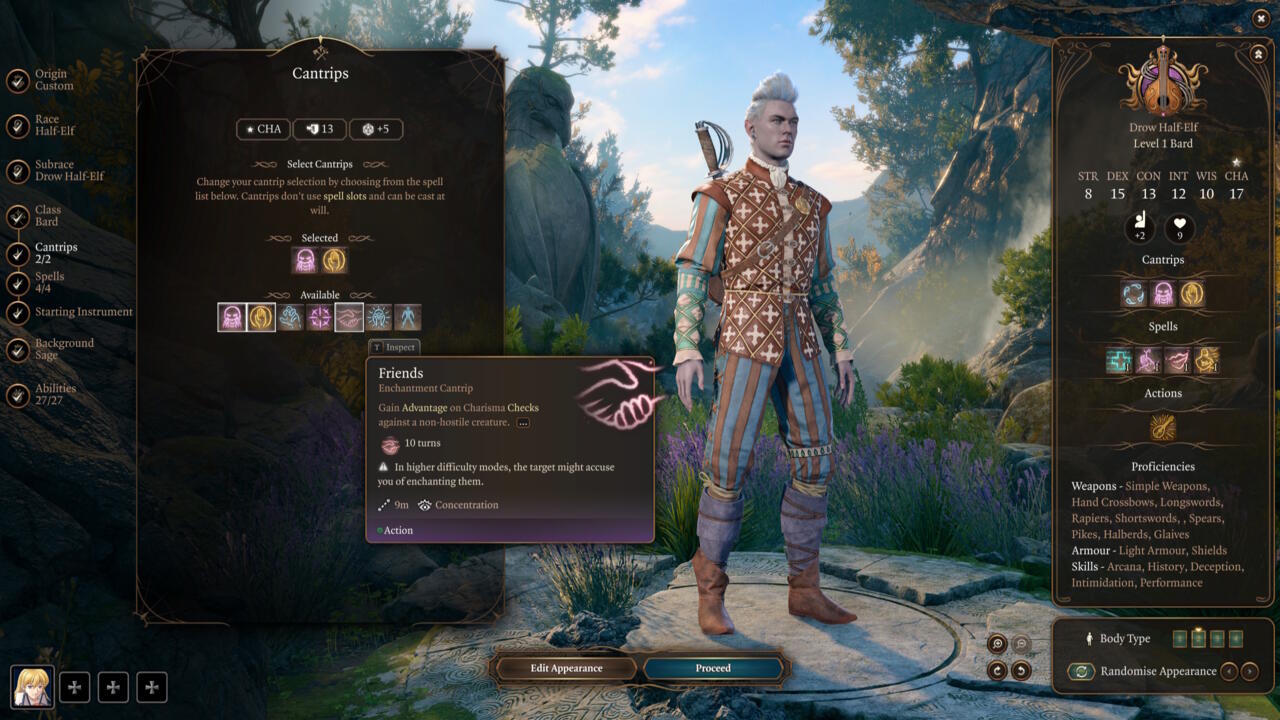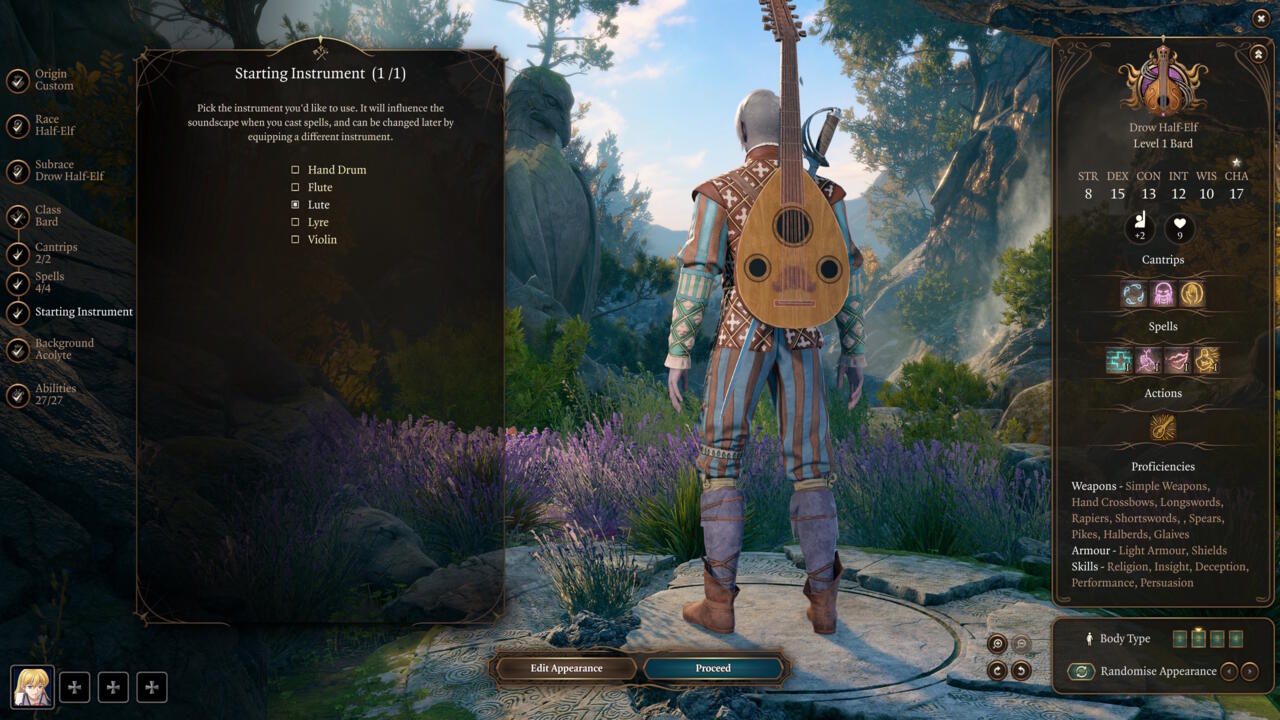Baldur’s Gate 3 Bard Class Guide
Our Baldur’s Gate 3 Bard class guide breaks down how the Bard works and which bonus perks work the best.
The Baldur’s Gate 3 Bard is an excellent class, straightforward enough for newcomers with enough depth and specialization options to keep experienced players interested. Getting started with a Bard is a bit easier than other classes thanks to the performer having fewer additional features, but there are a few key points to bear in mind when putting yours together.
Our Baldur’s Gate 3 Bard class guide breaks down how the Bard works and which bonus perks work the best.
Baldur's Gate 3 Bard class overview
The Bard lives up to their Jack-of-All-Trades trait, with a range of proficiencies across the board and the option to use spells, support skills, debuffs, and melee attacks. Their traits make them well-suited to combat and adventuring. Bards specialize in Charisma, which is the foundation for a good many social skill checks, including persuasion and intimidation. In addition to all that, the Jack-of-All-Trades trait adding a bonus point for every skill check roll.
Depending on which subclass you choose, you can even specialize your Bard as a melee fighter who holds their own in combat.
Bard Class Features
The Bard is comparatively straightforward, unlike the Monk, with their feature sheet consisting of two constitution overviews and their most important feature: Bardic Inspiration.
- Hit Points at level 1: 8 + Constitution modifier
- Hit Points at 5 + Constitution modifier
Bardic Inspiration lets you target one ally and grant them an extra six-sided die roll for their next attack, ability, or saving throw. You can use it in combat for a chance to power up a character’s next move or in exploration for some bonus points on that character’s next throw--but you can’t use it on yourself. If you’re using it in exploration, don’t forget to control the character under Bardic Inspiration so you actually get that benefit on a skill check throw.
The die increases to an eight-sided die at level 5 and a 10-sided die at level 10.
Bard Proficiencies
The Bard’s middle-of-the-road approach extends to their proficiencies with weapons and armor as well.
- Light Armor
- Simple weapons
- Hand Crossbows
- Longswords
- Shortswords
- Rapiers
- Starting Instrument: Your choice of drum, lute, lyre, flute, violin
- Saving throws: Dexterity, Charisma
- Skills: Choose any three
- Spells: Choose 2 Cantrips
- Begins with 2 Level 1 Spell Slots

Bard subclasses
The Bard can specialize in three subclasses, each of which builds on one of their unique aspects.
College of Lore
College of Lore Bards specialize in Arcana, Intimidation, and Sleight of Hand, gaining more spell slots as they level up along with access to the Magical Secrets spell branch at level six. If you want to turn your Bard into a support unit who helps allies and debilitates foes, this is the branch for you.
College of Valor
Valor Bards are little singing soldiers, performers who gain proficiency in heavier armor and deadlier weapons. You still get your spell slots and even an extra attack, but you don’t gain any other ability proficiencies that aren’t combat related.
College of Swords
College of Swords Bards lean more into complex melee attacks, with skills that can raise your armor level or push enemies away. They also gain proficiency in medium armor, scimitars, Deception, and Performance, so it’s a “best of both worlds” class.
Bard character creation tips
The Bard doesn’t have many moving parts to deal with, though your initial weapon proficiencies limit the selection of races to choose from.
Best Bard race
I recommend a High Elf for your Bard for a few reasons.
- Extra cantrip slot
- Immune to sleep magic
- Can see in the dark
- Saving throw to protect against charm
You could opt for something like a Drow or Tiefling to get a broader set of weapon proficiencies, but that extra Cantrip slot is the most important thing you can do for your Bard.

Best Bard background
The background you choose isn’t terribly important for your actual build, since it just adds two extra proficiencies. Some good Bard choices are:
- Charlatan, for Sleight of Hand and Deception
- Entertainer, for Performance
- Guild Artisan, for Insight and Persuasion
However, I picked Noble, a background with two proficiencies that fit my roleplaying idea and have nothing to do with my build, and I’m not suffering for it. The most important thing to keep in mind about your chosen background is that it influences how and when your character gains inspiration.
Best Bard stat point distribution
The starting stat spread the game recommends is a solid choice for the Bard.
- Strength - 8
- Dexterity - 15
- Constitution - 13
- Intelligence - 12
- Wisdom - 10
- Charisma - 17
Consider dropping Intelligence a few points and putting those into Strength if you opt for College of Swords, though.
We have many more guides to help you through Baldur's Gate 3, including romance options, quest guidance, build suggestions, and more. Find everything in our Baldur's Gate 3 hub.
Got a news tip or want to contact us directly? Email news@gamespot.com
Join the conversation